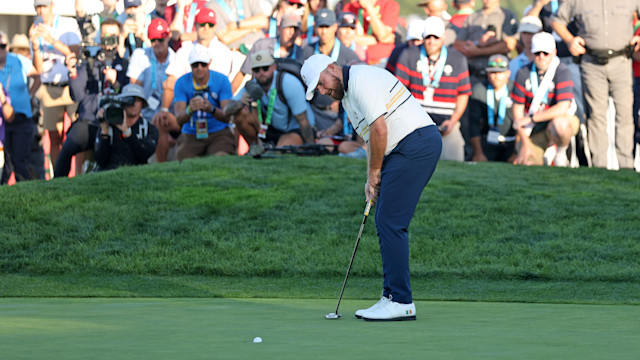quick coaching
Neal Shipley's 4 Short Game Secrets That Will Save You Strokes
By Brendon Elliott, PGA
Published on

Neal Shipley isn't overpowering The Pete Dye Course at French Lick Golf Resort. Yet the 24-year-old sits tied for the lead at Korn Ferry Tour Championship, positioned to potentially earn his third victory and immediate PGA TOUR promotion.
The statistics reveal his secret: Shipley ranks 59th in driving accuracy (46% of fairways) and tied for 44th in greens in regulation (58%). But he's gotten up and down 11 of 15 times (73%) and averages just 1.67 putts per green in regulation, fourth-best in the tournament.
This offers a masterclass for amateurs: you don't need perfect ball-striking to shoot low scores. A sharp short game equalizes everything.
Here's the recipe:
Prioritize Up-and-Downs Over Ball-Striking Perfection
The Tip: Shift practice focus from hitting more greens to saving more pars when you miss them.
Why It's Important: Most recreational golfers hit 20-40% of greens, missing 10-14 per round. Converting half those misses into pars through solid short game work immediately shaves 5-7 strokes off your score without changing your full swing. Shipley's 73% up-and-down rate at French Lick has neutralized his mediocre ball-striking, keeping bogeys off his card while birdies accumulate.

How to Develop This Skill: Track your up-and-down percentage during practice rounds to identify patterns. Dedicate 40% of practice time to short game work. For every hour on the range, spend 30 minutes around the practice green. Work on varied lies and situations: tight lies, fluffy lies, uphill and downhill chips. Develop one reliable go-to shot you can execute under pressure before expanding your repertoire.
Action Item: During your next three practice sessions, play the "Up-and-Down Challenge" for 30 minutes. Drop three balls randomly around the practice green. Give yourself one chip and two putts maximum to hole out. Aim for 50% success initially, then increase to 60%, then 70%.
Become a First-Putt Specialist
The Tip: Focus on eliminating three-putts and improving lag putting rather than obsessing over making everything inside 10 feet.
Why It's Important: Shipley's 1.67 putts per green tells us he rarely three-putts and frequently one-putts. Tour professionals make only 50% of putts from 8 feet and 40% from 10 feet, but they almost never three-putt. For amateurs, eliminating three-putts is the fastest path to lower scores.

How to Develop This Skill: Make lag putting practice your cornerstone. Start each session with 30, 40, and 50-foot putts, aiming to leave them within three feet of the hole. Develop a consistent pre-putt routine: read from behind the ball, pick your line, take practice strokes while visualizing, then execute. Practice putts to a tee rather than a hole to focus on distance control, the primary factor in three-putts.
Action Item: Play the "Lag Ladder" drill. Place tees at 20, 30, 40, and 50 feet from the hole. Hit three putts from each distance, trying to get all three within three feet. Score one point per ball inside three feet. Aim for at least 8 of 12.
Embrace Course Management
The Tip: Design strategy around your short game strengths rather than trying to overpower the course.
Why It's Important: Shipley plays smart golf that lets his short game shine. "I feel like I'm able to manage these tougher golf courses maybe a little better than some other guys," he noted. If you trust your short game, you can play aggressively in some situations and conservatively in others, always positioning yourself where your strengths take over.
How to Develop This Skill: Think in terms of "scoring zones" rather than greens in regulation. Your scoring zone might be anywhere within 30 yards where you're confident getting up and down. Before each round, identify holes where your short game can be a weapon. Learn to miss greens in the right spots. A ball rolling off the front into the fairway beats one flying into thick rough.
Action Item: During your next round, play a "short game strategy" experiment on five holes. Deliberately aim for green centers regardless of pin position, or aim so a potential miss is in ideal spots when pins are dangerous. Track whether this conservative strategy, combined with aggressive short game play, produces better scores
Build Confidence Through Pressure Practice
The Tip: Practice your short game under simulated pressure to build confidence in your execution.
Why It's Important: Shipley's 73% up-and-down rate in a championship event results from countless pressure-packed practice hours. His chip-in birdie on the par-5 14th during Friday's round demonstrates confidence from executing these shots hundreds of times before. When you believe you can get up and down, you play tee-to-green shots with less tension.

How to Develop This Skill: Introduce consequences to practice. Hitting chips without stakes doesn't replicate needing to save par. Create games with win-or-lose outcomes. Play nine holes on the practice green, dropping balls in different spots, chipping on and putting out. Set a target score and track achievement. Before each chip, visualize real scenarios: "This is for par on 16. I need this within three feet."
Action Item: Create a "pressure points" session. Set up five different short game scenarios representing crucial round moments. Give yourself only one attempt at each with no do-overs. You must get up and down on three of five to "win." This single-attempt format builds pressure-handling skills.
The Bottom Line
Start by shifting practice priorities. Spend more time around greens, less on perfecting your driver. Track your up-and-down percentage and putts per round. Create pressure situations that mirror real-life golf scenarios.
Your path to lower scores doesn't require a swing overhaul. It requires commitment to mastering the scoring zone where average ball-striking still produces exceptional scores.
PGA of America Golf Professional Brendon Elliott is an award-winning coach and golf writer. Read his recent “Playing Through” on R.org and his stories on Athlon Sports. To stay updated on his latest work, sign up for his newsletter and visit OneMoreRollGolf.com.


